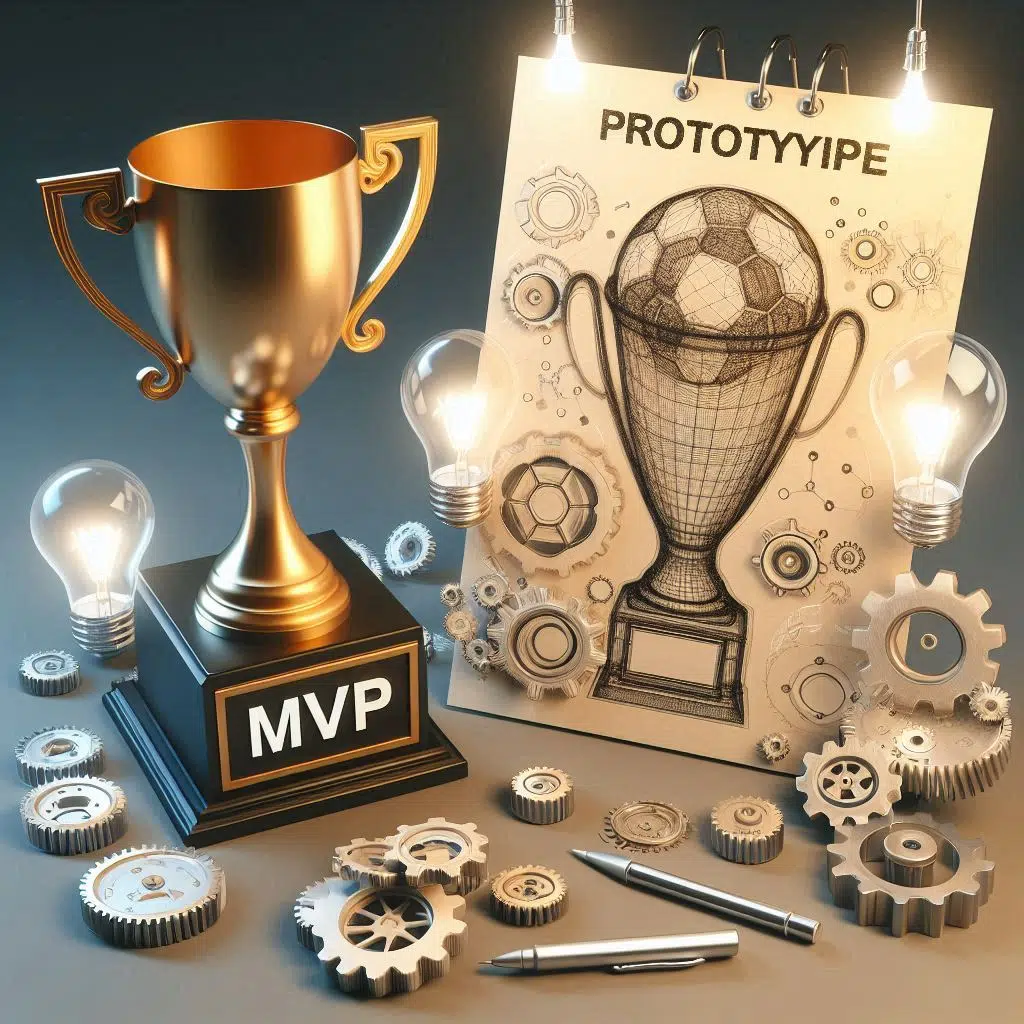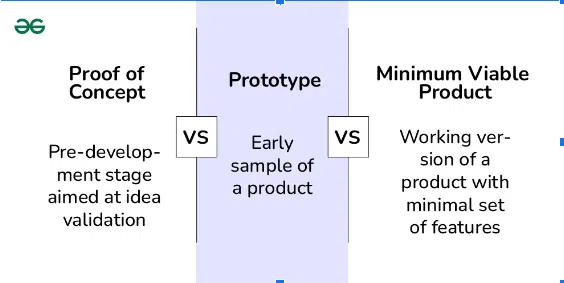MVP vs Prototype: Understanding the Differences and When to Use Each
If you have a great idea but aren’t taking action, it might be time to rethink your approach. You can start with a prototype or minimum viable product (MVP) to get things rolling. This way, you can test and then fine-tune your idea without waiting for someone else to bring it to life. Besides, you don’t have to spend a fortune to get started. If you’re confused about whether to begin with an MVP vs prototype, you’re not alone.
Want to know more about how to get from your dream to a working product? Read on.

MVP vs Prototype
What’s an MVP?
This acronym MVP stands for Minimum Viable Product, which means exactly what it says: it is all about a ready-to-use website or mobile app. However, it’s equipped with a small set of features. These features are needed for the product to function, thus meeting one of the key MVP requirements: delivering maximum value to users in the shortest amount of time and on the smallest budget. Unlike building a full-featured product, a Minimum Viable Product saves you resources as you don’t have to spend a fortune on it. The good thing about MVP is that it allows you to hear from your potential customers. It’s not about fantasies anymore, it’s about what your real customers need.
When comparing MVP vs prototype, it becomes clear that an MVP focuses on creating a minimal version of the product that solves users’ problems quickly. According to a report by CB Insights, 42% of startups fail because there is no market need for their product. An MVP helps to avoid this pitfall by allowing companies to validate their concept early. To put this validation process into action, many businesses work with an experienced MVP development company to build an early product version that can be tested with real users.
What’s a Prototype?
Prototyping is about building an early, simplified version of your product. This helps you get an idea off the ground quickly and grow it. Or not, so you can let that idea go and move on to something else. A prototype is a tangible form of your product, such as a sketch on paper or a smaller version of the product made from improvised objects.
When considering MVP vs prototype, a prototype is a great starting point to validate ideas. It’s not a product yet, and nothing in the prototype works. However, you can discuss the possibility of building a product with the engineering team based on this concept. Prototypes can range from simple sketches to detailed mock-ups that help visualize the product. A prototype can be simple or complex – there are no clear requirements.
Prototype vs MVP: What’s the difference?

Source: https://www.geeksforgeeks.org/proof-of-concept-vs-prototype-vs-minimum-viable-product/
MVP vs prototype are not the same thing. The main difference between the two approaches is that they are applied at different stages of product development:
- First, a prototype is built to get a feel for the idea and test the waters;
- If the idea is validated, then an MVP is created to bring the core functionality to the market.
What the two have in common is that both the prototype and the MVP help reduce risk in terms of money and time. These are good ways to handle not only your products but also those of your customers. The MVP development process emphasizes speed and user feedback, while a prototype is about visualizing the concept and testing it early.
In terms of MVP vs prototype, you need to assess the stage of your project. If you’re just mapping out ideas, start with a prototype. But if you’re ready to bring core functionality to users, go with an MVP.
MVP vs Prototype: Which to choose?
Working with your direct contractor will help you better understand the differences between prototyping and MVP development. For example, if you choose IT outsourcing for your development tasks, chances are you’ll get advice based on experience, as these professionals have extensive experience in software development projects with a wide range of different tasks.
However, it’s a good idea to familiarize yourself with the list of MVP vs prototype use cases now so that you can decide whether to go for the former or the latter.
When Should I Choose an MVP?
It’s safe to say that every project benefits from an MVP. However, some organizations need an MVP more than others under certain circumstances. When it comes to the MVP vs prototype debate, startups often benefit more from MVPs due to budget constraints. A study by Failory shows that 90% of startups fail, and one major reason is running out of money, which emphasizes the importance of creating a lean MVP to avoid unnecessary costs.
- You are a startup:
Long story short, it’s all about reducing risk for startups and navigating budget constraints wisely. Especially when it comes to spending money. The product development budget turns out to be even more important than the complexity of the product itself. Money is the main reason why projects fail. According to statistics, 38% of startups fail because they run out of money while working on a product. That’s why creating an MVP version of a product is so important – it will help you move ahead with confidence.
 Source: https://jobera.com/startup-failure-statistics/
Source: https://jobera.com/startup-failure-statistics/
- When you need to test ideas:
Creating an MVP lets you try out your ideas, get feedback from real users, and figure out how much money you need before you go all in on building the full product. By asking your audience what they want, you can see if there’s a real need for your product in the market.
- When you need to release new features:
MVP helps to assess user interest in new features, thereby reducing the risk of spending extra money on developing unnecessary functions. Instead, you can add features through iteration, ultimately resulting in an easy-to-use product without spending too much money.
Additionally, an MVP helps when you need to test ideas with real users or launch a product with basic functionality to get feedback before committing to full development.
When Should I Choose a Prototype?
There are many situations where it makes sense to start prototyping. When your product is complex or you need to show stakeholders a visual representation of your idea, a prototype is ideal. In the MVP vs prototype comparison, the prototype stands out for projects in the initial conceptualization stage. Prototyping can also help when your product design needs to be mapped out before involving developers, or when the requirements may change rapidly.
There are many situations where it makes sense to start prototyping. Let’s look at some of them below.
- When your product is complex from the start:
Indeed, when a product is overly complex and needs to scale with new features and other systems, visualizing the entire process and its interrelationships becomes a relief. Creating a prototype is the first piece of advice we would give to those running a new peer-to-peer e-commerce website, for example. However, prototyping an idea is helpful in other areas as well.
- When you need to show investors or customers what the product looks like:
Sometimes words aren’t enough, and instead of giving a persuasive speech, it’s better to demonstrate the concept of your idea once. With a prototype, stakeholders will better understand the product idea and upcoming changes, which will help them make more reasonable decisions.
- When requirements are not defined or change quickly:
Having a prototype gives the product development process the flexibility it needs to iterate and change. If the requirements are unclear or change during the process, it’s best to visualize how they affect the product by prototyping.
The reasons for choosing prototyping seem more than compelling when we consider the essence of low-code development, which is that “the future belongs to those who can prototype, iterate, and adapt with agility.
Bottom Line
Now that you have a good understanding of MVP vs prototype, it will probably be easier for you to decide where to start. If you haven’t yet tested the waters and your idea is just your imagination, you should begin by creating a prototype. This approach will help shed light on the structure, functionality, and how it all comes together within the product. If the idea has already been tested and all you need to do is get the product to market quickly, then, of course, MVP along with a well-developed, albeit basic, product design is the way to go.
In the MVP vs prototype comparison, whichever you choose can help you avoid unnecessary costs and reduce risks or difficulties that companies typically face in the early stages.
From Tech Consulting, Mobile App Development Services, Web App Development Services to #1 Vietnam outsourcing software service! Since 2009, Savvycom has been harnessing digital technologies for the benefit of businesses, mid and large enterprises, and startups across the variety of industries. Savvycom dedicated software development team can help you to build high-quality custom software development services and products as well as deliver a wide range of related professional services.
Savvycom is right where you need. Contact us now for further consultation:
- Phone: +84 24 3202 9222
- Hotline: +1 408 663 8600 (US); +612 8006 1349 (AUS); +84 32 675 2886 (VN)
- Email: [email protected]

